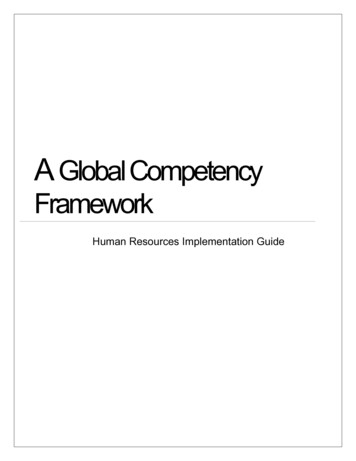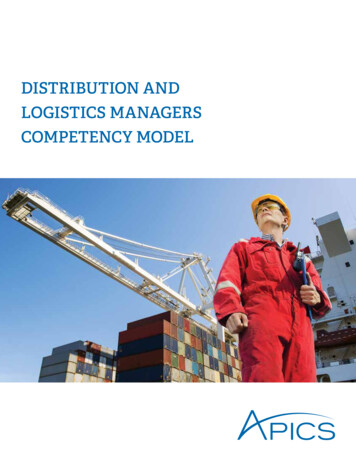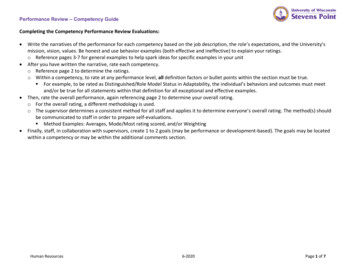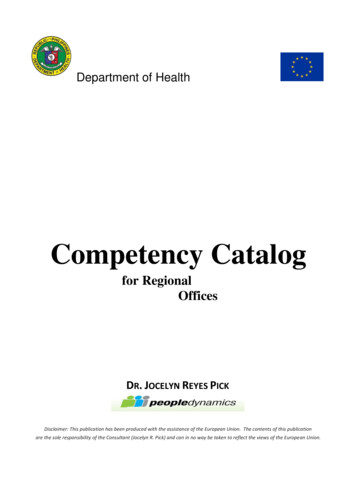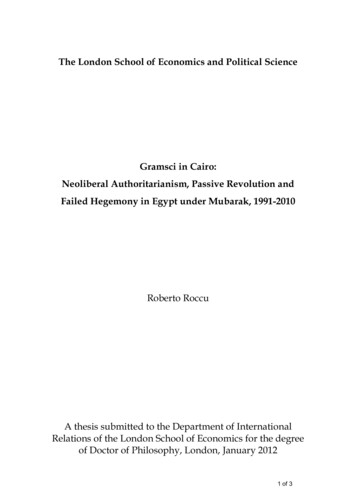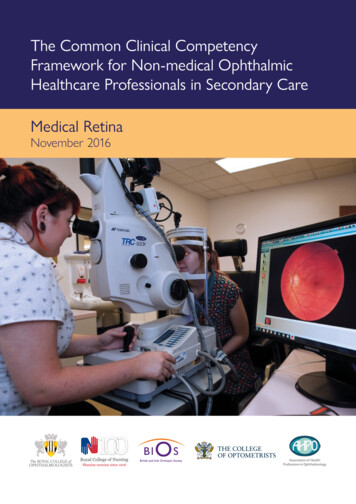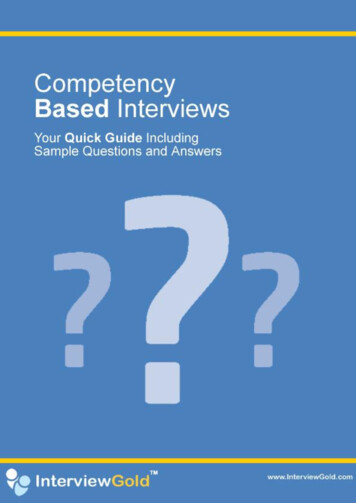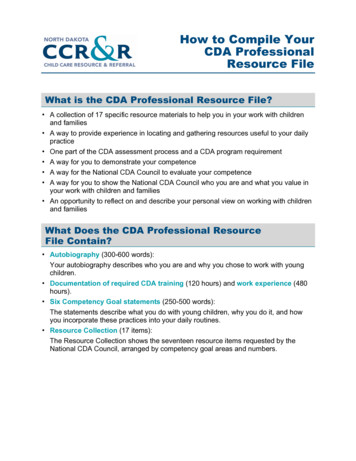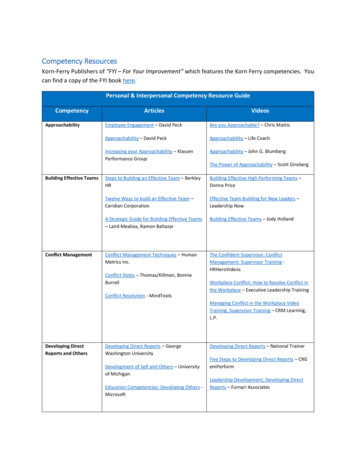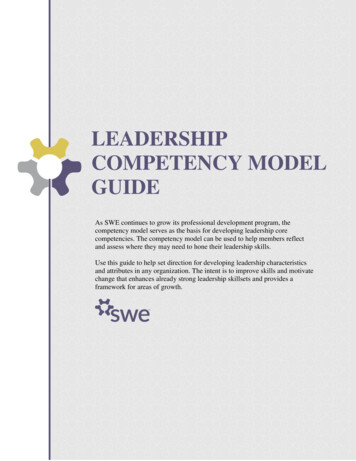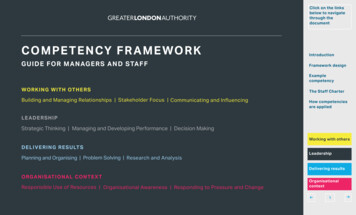
Transcription
Click on the linksbelow to navigatethrough thedocumentC OMP E TE NCY FR AME WO R KGUID E FO R M A NAGE RS AN D STAF FIntroductionFramework designExamplecompetencyWO R K I N G W I T H OT H E R SBuilding and Managing Relationships Stakeholder Focus Communicating and InfluencingThe Staff CharterHow competenciesare appliedLEADERSHIPStrategic Thinking Managing and Developing Performance Decision MakingD E L I V E R I N G R E S U LT SPlanning and Organising Problem Solving Research and AnalysisO RG A N I S AT I O N A L C O N T E X TResponsible Use of Resources Organisational Awareness Responding to Pressure and ChangeWorking with othersLeadershipDelivering resultsOrganisationalcontext 1
Click on the linksbelow to navigatethrough thedocumentINTRODU CTIO NThe Greater LondonAuthority’s competencyframework outlines thebehaviours that are essentialto effective performancein our organisation. Theframework forms the basisof our people managementprocesses and providesa common language forHOW we go about our dailywork (while performanceobjectives describe WHATwe do). It helps us manageand improve performanceand build a better, moreeffective organisation. Thisguide provides informationfor both managers andstaff on using behaviouralcompetencies within theGLA across different peoplemanagement processes.What is a CompetencyFramework?A competency frameworkis a set of behaviours orskills that are essential foreffective performance in anorganisation, and that canbe measured and observed.The GLA competencyframework is made up ofbehavioural competencies,which are concerned withHOW we perform our roles,HOW we apply our technicalknowledge and meet ourperformance objectives.The competency frameworkapplies to and enhancesa variety of peoplemanagement processes: Job role profiling Recruitment and selection Performance managementand review Learning and careerdevelopmentWhy we have aCompetency FrameworkThe framework allows us toeasily identify the behavioursthat drive successfulperformance and enablesus to deliver our technicalexpertise effectively.Defining how we do ourtasks is particularlyimportant in establishingcommon ground aroundwork practices. How weare expected to behavein delivering the prioritiesset down in key corporatedocuments. Behaviouralcompetencies are a signalfrom the organisationto the individual of theexpected areas and levelsof performance. Theyprovide the individualwith an indication of thebehaviours that are valuedand recognised. A Common Language andBenchmark - Behaviouralcompetencies have beendeveloped for the wholeorganisation and thereforebecome a commonlanguage and benchmarkthat we can use across theorganisation when we talkabout people’s behaviouralperformance. Clarity - Behaviouralcompetencies clearly setout for staff and managersthe behaviours that arerequired in each area ofthe organisation in orderto be successful. Thishelps people understandwhat is expected of themand gives them greaterclarity about their team,and individual roles withinit. Understanding thebehaviours that otherareas of the organisationsee as essential toeffective performancealso helps us to improvehow we work together. Focus - As behaviouralcompetencies emphasisethe behaviours that arecrucial for success in theorganisation, they provideus with a clear focus fordevelopment. Not only dothey help staff and theirline managers have a morefocused developmentdiscussion, they also helpus to take charge of ourown development. Ourdevelopment actionsbecome more focused asa result and we work moreeffectively with peopleacross the organisation.Further informationIf staff or managers haveany questions about thecompetency framework orrequire further informationregarding its applicationthey should contact:Human Resources& OrganisationalDevelopmentIntroductionFramework designExamplecompetencyThe Staff CharterHow competenciesare appliedWorking with othersLeadershipDelivering resultsOrganisationalcontext 2
Click on the linksbelow to navigatethrough thedocumentF R A ME WOR K DE SIG NThrough a series ofworkshops, face toface interviews andquestionnaires, we gatheredinformation from over 100staff to understand whatbehaviours are essentialfor successful performanceacross the GLA, acrossdifferent levels in theorganisation, and withinspecific functional groups.This information wasanalysed to isolate corethemes. The themescomprise separate anddistinct behaviours thatare needed to deliver ourwork - the 12 competencies.We identified links betweencompetencies and groupedthem into 4 competencyclusters: Working withOthers, Leadership,Delivering Results andOrganisational Context.We analysed the data furtherto reveal how the behavioursdiffer from junior to seniorroles. This gave us our 4competency levels, eachcorresponding to roles withinthe GLA structure. The levelsare cumulative which meansthat a staff member in a levelthree role would be expectedto be demonstratingthe positive behavioursfrom levels one to three.Reflecting the organisationalhierarchy,’ start sentence:The majority of roles at theGLA have competencies atlevel two and three.Within each competencylevel there are 4-6behavioural indicators thatare the essential behavioursneeded to demonstrate thatcompetency effectively.These indicators providea clear indication of thecontribution at differentlevels within the GLA,which is crucial to theorganisation’s performanceas a whole. These indicatorsare designed to provide afocus for discussions aboutperformance, developmentand recruitment. Theindicators should not beviewed as a ‘checklist’ andthey do not represent anexhaustive list of examples.The draft framework wastested out with staff togather information onthe look and feel of thecompetencies, levels andbehavioural indicators.Further workshops were heldto check that this frameworktruly works within the GLA.Level 4 - seniormanagement. Examples:Chief Executive, ExecutiveDirector, Assistant Directorand Head of Unit.Level 3 - middle managers,senior professional, policyand project roles. Examples:Senior Systems Engineer,Policy Manager, ChiefAccountant.Level 2 - first line managers/team leaders, professional,policy and projectofficer roles. Examples:Policy Officer, BusinessCoordinator, HR Advisor,Public Services Co-ordinator.Level 1 - front-line FMstaff, administrative andentry level policy andprofessional roles. Examples:Project Support Officer,Administrator, Assistant HROfficer, Security, Mailroom &porterage Team Member.IntroductionFramework designExamplecompetencyThe Staff CharterHow competenciesare appliedWorking with othersLeadershipDelivering resultsOrganisationalcontext 3
Click on the linksbelow to navigatethrough thedocumentE X A M P L E COM PE T E NCYCompetency definitionExplanation why thiscompetency is importantB U IL DIN G A N D MA N AG IN G R E L AT IO N S H I P S is developing rapport and working effectively with a diverse range of people, sharing knowledge and skills to deliver shared goals.The four levelsThe Staff CharterFramework designP Builds rapport quickly with people at all levels and from different backgroundsP Develops new professional relationshipsP Actively listens to others and is open to their ideasP Understands the needs of others, the constraints they face and the levers toExample competencyP Understands differences, anticipates areas of conflict and takes actionThe CompetencyFramework and theStaff CharterHow competenciesare appliedLE V E L 1Identifies and resolves conflict between self and othersP Makes others feel comfortable and respected by being positive and friendlyP Shares information openly with colleagues within and outside own teamÏ Interacts awkwardly or inappropriately with othersÏ Doesn’t consider impact of own behaviour on otherstheir engagementP Fosters an environment where others feel respectedP Identifies opportunities for joint working to minimise duplication and delivershared goalsHow competenciesare appliedÏ Makes little effort to maintain contact or relationshipsÏ Limits interaction to a chosen fewP Actively engages partners and encourages others to build relationships thatP Identifies and engages a diverse range of influential contacts within stakeholderP Understands and recognises the contributions that staff at all levels make toP Builds alliances to establish mutually beneficial working arrangements, openlyP Proactively manages partner relationships, preventing or resolving any conflictP Actively challenges and addresses ‘silo attitudes’ to encourage effectivesupport GLA objectivesdelivering prioritiesLEVEL 3Indicators of ineffectiveperformance ÏExamplecompetencyIntroductionIndicators of effective P and ineffective Ï performancePIndicators of effectiveperformance PClick on the linksIntroductionbelow to navigatethrough thedocumentFramework designWhy is it important? Having good working relationships with colleagues and effective alliances with external partners will help create anorganisation people want to work with, enabling more effective delivery of the organisation’s strategic priorities.LE V E L 2Competency titleWO RKI N G W I T H OT H E RS C LU ST E RP Adapts style to work effectively with partners, building consensus,trust and respectP Delivers objectives by bringing together diverse stakeholders to workeffectively in partnershipÏ Invests time in relationships that have limited organisational benefitÏ Misses opportunities to build new relationships or work in partnershipand community groups, and partner organisationssharing knowledge and insightsLEVEL 4Cluster titlerelationship building inside and outside the GLAP Understands the complexities of political dynamics and uses this to managerelationships and resolve conflict effectivelyP Identifies clear win-win situations with external partnersÏ Builds relationships with limited contacts, or those from local or similarstakeholder groups.Ï Forms one sided partnership arrangements that only benefit the GLAWorking with othersWorking with othersLeadershipLeadershipDelivering resultsDelivering resultsOrganisationalOrganisationalcontextcontext 84
Click on the linksbelow to navigatethrough thedocumentT H E STAF F C HART E RThe Charter describeswhat the GLA commits toas an organisation, andwhat is expected of staffto make sure we meet thisorganisational commitment.The Charter can be used bystaff - to help them reviewif they are meeting theminimum expectations and by managers - to ensurethat the way they managestaff is consistent with theorganisational standards.Staff and managers areexpected to discuss theCharter within one to one orteam meetings and considerhow the way they work couldbe improved.There are clear links betweenthe Staff Charter and thecompetency framework.The behaviours in thecompetency frameworksupport staff to delivertheir commitments outlinedin the Staff Charter, andboth documents outlinebehaviours essential foreffective performance.Organisational valuesexpressed in theStaff Charter such asAccountability, Collaboration,Fairness and Integrityare embedded asthemes throughout thecompetency framework.The GLA commits to: Leadership and accountabilityStaff commit to: Leadership and accountability Being an organisation that empowers and develops staff, maximising talent,skills and experience Striving to improve their own performance and suggesting improvements for teamand organisational performance Providing a clear strategic vision and priorities supported by a strong,inspiring leadership team Managers leading by example, celebrating successes, recognising everybody’sroles and contributions, and addressing underperformance Focusing on delivering the best possible outcomes and value for money forLondoners at all timesStaff commit to: Collaboration Clear lines of accountability and responsibility Being open to giving and receiving constructive feedback and thanking colleaguesfor their contribution An open and constructive joint working relationship with elected politicians &political appointeesThe GLA commits to: Fairness and integrity Working to build trust both internally and with the GLA group,partners and stakeholders Communicating in an open, transparent and honest way with staff,partners and stakeholders Respecting and considering the diverse needs of all staff and ensuringtheir wellbeingFramework designExamplecompetencyThe Staff CharterHow competenciesare applied Giving constructive feedback, engaging fully with organisational development andtaking responsibility for their actionsThe GLA commits to: Collaboration Consulting and informing staff, Londoners and other stakeholders aboutGLA priorities and plans, with clarity about what is expected of staff indelivering themIntroduction Collaborating with colleagues, working efficiently and flexibly to cut out duplicationand share knowledge Being responsive, efficient and polite when dealing with colleagues, partners andstakeholders to build trust in the organisation and with elected Assembly MembersStaff commit to: Fairness and integrityWorking with othersLeadershipDelivering results Treating everyone with professional and personal respect, promoting fairness andrecognising the value of diversityOrganisationalcontext Challenging inefficient processes and inappropriate behaviours which act asbarriers to improvement Showing integrity through honesty, ethical behaviour and open communication5
H OW COMP E T E N C IE S ARE A PPL IE DCompetencies and jobrole-profilingThe competency frameworkprovides a selection ofbehavioural competenciesthat are important forperformance across theorganisation. For eachindividual role a smallerselection of competencies isimportant for job success.All roles within the GLAshould have between 5 and8 competencies identifiedas essential for effectiveperformance in the job.Non-managerial rolesshould have about 5-6and managerial roles 7-8competencies (includingManaging and DevelopingPerformance) insertedinto the job description(person specification). Thecompetencies replace vague‘soft skill’ requirements.This is aimed to ensure aconsistent and transparentstandard across theorganisation and replacevague or hard to measurerequirements such as‘communication skills’,‘ability to negotiate andinfluence stakeholders’,‘management skills’ etc.The other requirements,such as specific experience,technical skills or relevantqualifications, remain inthe person Using behaviouralcompetencies forrecruitment ensures thatany selection process isfocused on the behavioursthat are important forsuccess in that role.Behavioural competenciesform the basis of a numberof selection tools, forexample, competency basedinterviews and assessmentcentres. Basing our selectiontools on our competencyframework enables us toengage in objective andstandardised selectionacross the organisation. Drafting Job Descriptions /Person Specifications A job description providesan overview of the jobtasks and responsibilities,and a person specificationdescribes the qualities(experience, knowledge,skills and behaviours) aperson needs to do the job.Through careful analysisof the job requirements,we can identify thecompetencies that areessential to successfulperformance in that job.These competenciescan then be includedin the job description /person specification asrequirements of the role.Knowing the competenciesthat are desirable fora given role means wecan adapt our selectiontools to assess thesecompetencies. Competency BasedInterviews - A competencybased interview is a typeof interview used toevaluate a candidate’sbehavioural competenceto do a particular role.Each question is targetedat obtaining behaviouralexamples for a specificcompetency. The candidateis asked to provideconcrete examples, fromtheir previous experience,of when they demonstratedthe behaviour in question.A scoring guide - basedon the GLA competenciesand behavioural indicators- is used to assess thecandidate’s responseagainst the behaviouralindicators for thatcompetency, enablingline managers to applyconsistent benchmarkswhen conducting interviews.Competency-basedPerformance ManagementUsing behaviouralcompetencies forperformance managementhelps us to improveperformance by clearlyoutlining what is expected ofus in terms of HOW we doour job.Job performance can besplit into:Click on the linksbelow to navigatethrough thedocumentIntroductionFramework designExamplecompetencyThe Staff CharterHow competenciesare applied WHAT specific targets orobjectives an individualachieves HOW an individual works(behavioural performance)The competency frameworkprovides a useful structure fordiscussing HOW an individualworks, their behaviouralperformance. This is howeverone aspect of a performancereview and does not replacea review of performanceagainst objectives. Performance Review To review behaviouralperformance, we need tofirst define what makesWorking with othersLeadershipDelivering resultsOrganisationalcontext 6
a good GLA employeein the role the individualfulfils. Knowing whichcompetencies are criticalfor an individual role (basedon the role-profiling, seeabove) allows managersto tailor their performancemanagement anddevelopment discussionsaccordingly.Staff and managers arejointly responsible forgathering evidence ofwhen the individual hasdemonstrated these jobimportant behaviours inthe workplace. Focusingindividuals on behaviouralcompetencies in their dayto-day work can help themunderstand their strengthsand how they might improvetheir performance.The performance reviewmeeting provides anopportunity to discusshow an individual worksand the behaviouralexamples that have beengathered. The section ofthe performance reviewform where competenciesare identified as strengthsversus development needs,can be used to help structurethe discussion and feedbackaround how an individualperforms against thebehaviours that are importantfor successful performancein their role and team. Probation – Competenciesform part of theperformance standards,which are set andmonitored as part ofthe probation process.They should be referredto when discussing thedevelopment needs andplanning developmentactivities to help theprobationer meet therequirements necessary toconfirm their appointment. 360-degree feedback – toprovide rounded feedbackon performance againstcompetencies, staff mayconsider undertaking360-degree feedbackreviews, where feedback isgathered from colleagues,staff, managers and otherimportant internal andexternal stakeholders. Thecompetency frameworkcan provide structure and abenchmark, against whichperformance is assessed.Feedback gathered in sucha way can be collected andprovided by the Learning &Development Team.Competency-basedLearning and DevelopmentThe competency frameworkprovides a set of behavioursthat can be used by staff andmanagers to lead and takeresponsibility for their ownlearning and development.Staff are able to identifyareas they may wish todevelop within their ownrole, but also they are able tounderstand the behaviouralcompetencies required for anew role or promotion.For the organisation, thebehavioural competenciescan be incorporated into ourtraining and developmentactivities so that we areactively developing thebehaviours that we know tobe essential to success in ourorganisation. Career Development - Weneed to take responsibilityfor our own careerprogression. Whether itis progressing upwards,or making a lateralmove, the behaviouralcompetencies help usidentify what the new rolerequires and how we needto develop in preparationfor a career move. Thebehavioural competenciesalso allow staff to seewhich behaviours aretransferable across roles.Independently, or with amanager, staff can use thecompetency frameworkto formulate a personaldevelopment plan for thebehaviours they wish todevelop to become moreeffective within currentrole and/or preparing forthe next role. Learning and DevelopmentActivities - Within theorganisation, we run anumber of developmentactivities. We design ourtraining in such a way thatwe aim to develop thecompetencies within ourframework. This tailorsour training provision tothe competencies thatare needed for theorganisation toperform well. Learning Needs Analysis The competency frameworkallows us to conductindividual, team andorganisation wide trainingneeds analysis whenthe need arises. We canidentify the competenciesthat individuals or groupsof people need to developand direct our traininginvestment where itis needed most. Thecompetency cardsprovide a simple andeffective tool for learningneeds analysis thatindividuals can use ontheir own or with theirline managers.Other toolsIn addition to this guide,staff and managers willhave the following toolsavailable to support themin effective application ofthe framework: Competency-basedrecruitment andselection guide Bank of competencybased interviewquestionsClick on the linksbelow to navigatethrough thedocumentIntroductionFramework designExamplecompetencyThe Staff CharterHow competenciesare applied Performancemanagement guidelines Probation guidelines Learning & OrgnisationalDevelopment frameworkWorking with othersLeadershipDelivering resultsOrganisationalcontext 7
WOR KI NG W I T H OT H E R S C LU STE RB U ILD IN G A ND M A NAG I N G RE L ATI ON S H I P S is developing rapport and working effectively with a diverse range of people, sharing knowledge and skills to deliver shared goals.Click on the linksbelow to navigatethrough thedocumentWhy is it important? Having good working relationships with colleagues and effective alliances with external partners will help create anorganisation people want to work with, enabling more effective delivery of the organisation’s strategic priorities.IntroductionIndicators of effective P and ineffective Ï performanceP Builds rapport quickly with people at all levels and from different backgroundsP Develops new professional relationshipsP Actively listens to others and is open to their ideasP Understands the needs of others, the constraints they face and the levers toP Makes others feel comfortable and respected by being positive and friendlyP Shares information openly with colleagues within and outside own teamÏ Interacts awkwardly or inappropriately with othersÏ Doesn’t consider impact of own behaviour on otherstheir engagementP Understands differences, anticipates areas of conflict and takes actionLE V E L 2LE V E L 1P Identifies and resolves conflict between self and othersP Fosters an environment where others feel respectedP Identifies opportunities for joint working to minimise duplication and delivershared goalsÏ Makes little effort to maintain contact or relationshipsFramework designExamplecompetencyThe Staff CharterHow competenciesare appliedÏ Limits interaction to a chosen fewsupport GLA objectivesPUnderstands and recognises the contributions that staff at all levels make todelivering prioritiesLE VE L 3P Proactively manages partner relationships, preventing or resolving any conflictP Adapts style to work effectively with partners, building consensus,trust and respectP Delivers objectives by bringing together diverse stakeholders to workeffectively in partnershipÏ Invests time in relationships that have limited organisational benefitÏ Misses opportunities to build new relationships or work in partnershipP Identifies and engages a diverse range of influential contacts within stakeholderand community groups, and partner organisationsPBuilds alliances to establish mutually beneficial working arrangements, openlysharing knowledge and insightsP Actively challenges and addresses ‘silo attitudes’ to encourage effectiveLE VE L 4P Actively engages partners and encourages others to build relationships thatrelationship building inside and outside the GLAP Understands the complexities of political dynamics and uses this to managerelationships and resolve conflict effectivelyP Identifies clear win-win situations with external partnersÏ Builds relationships with limited contacts, or those from local or similarstakeholder groups.Ï Forms one sided partnership arrangements that only benefit the GLAWorking with othersLeadershipDelivering resultsOrganisationalcontext 8
WOR KI NG W I T H OT H E R S C LU STE RSTAKE HO L D E R FO CU S is consulting with, listening to and understanding the needs of those our work impacts and using this knowledge to shape what we do andmanage others’ expectations.Why is it important? Stakeholders are anyone (internal or external) on whom our work impacts. We need to manage their expectations,respond to their aspirations and use diverse views to shape our work and deliver our vision for London.Indicators of effective P and ineffective Ï performanceP Demonstrates an enthusiastic and ‘can do attitude’ to all requestsP Provides timely, accurate and personalised responsesLE V E L 1P Provides a polite and helpful first point of contact for stakeholdersP Learns from feedback to improve personal service to othersÏ Is unhelpful or unprofessional when interacting with stakeholdersÏ Ignores requests, or problems, until someone complainsIntroductionP Seeks to understand requirements, gathering extra information when needsFramework designP Presents the GLA positively by interacting effectively with stakeholdersExamplecompetencyare not clearP Delivers a timely and accurate serviceP Understands the differing needs of stakeholders and adapts ownThe Staff CharterP Seeks and uses feedback from a variety of sources to improve the GLA’sHow competenciesare appliedLE V E L 2P Listens to understand requirements without making assumptionsClick on the linksbelow to navigatethrough thedocumentservice accordinglyservice to LondonersÏ Responds to stakeholder needs in a generic way, irrespective of varyingstakeholder needsÏ Shows little interest in gaining feedback to improve interactionwith stakeholdersP Understands diverse stakeholder needs and tailors teamP Adapts objectives and the GLA’s public facing position based on the contextWorking with othersP Is a role model to others, encouraging them to think of Londoners firstP Builds the GLA’s reputation as an organisation committed to meeting the needsLeadershipLE VE L 3P Manages stakeholder expectations, so they are high but realisticP Removes barriers to understanding the needs of diverse stakeholders,including hard to reach groupsP Focuses own and team’s efforts on delivering a quality and committed serviceÏ Allows own and team’s interaction with stakeholders to remain staticÏ Tolerates poor service levels from others; does not encouragecontinuous improvementbehind stakeholder needs and requestsof LondonersP Manages partner organisations’ and Londoners’ expectations of the GLA byLE VE L 4deliverables accordinglyanticipating and influencing changing prioritiesP Instils a culture that encourages GLA staff to think about meeting Londoners’needs firstDelivering resultsP Builds the confidence of staff, partner organisations and Londoners by ensuringOrganisationalcontextÏ Does little to encourage the organisation to think about the needs of Londoners the GLA delivers quality workand partner organisationsÏ Accepts outcomes that do not meet the diverse needs of Londoners9
WOR KI NG W I T H OT H E R S C LU STE RC OMMUN I CAT I NG A ND I N F LU E N C I N G is presenting information and arguments clearly and convincingly so that others see us as credible and articulate, and engage with us.Click on the linksbelow to navigatethrough thedocumentWhy is it important? So that we can effectively engage our diverse audience - colleagues, external partners and Londoners - and ensure theyunderstand, respond to what we do and help us to deliver.IntroductionIndicators of effective P and ineffective Ï performanceP Represents self and team positively within the organisationP Communicates openly and inclusively with internal and external stakeholdersP Speaks and writes clearly and succinctly using appropriate language that isP Clearly articulates the key points of an argument, both in verbal and writtenP Considers the target audience, adapting style and communication methodP Persuades others, using evidence based knowledge, modifying approach toaccordinglyP Communicates persuasively and confidentlyP Checks for understandingcommunicationLE V E L 2LE V E L 1easy to understanddeliver message effectivelyP Challenges the views of others in an open and constructive wayP Presents a credible and positive image both internally and externallyÏ Communicates in a way that others find difficult to understandÏ Excludes others when communicatingÏ Presents views negatively or without convictionÏ Fails to gain buy in to important messagesP Encourages and supports teams in engaging in transparent and inclusiveP Articulates self with credibility and conviction, encouraging buy-in toP Influences others and gains buy-in using compelling, well thought throughP Influences the thinking of other organisations, encouraging them to deliver inP Negotiates effectively to deliver GLA prioritiesP Ensures that the organisation communicates inclusively with staff andLE VE L 3argumentsP Synthesises the complex viewpoints of others, recognises where compromiseis necessary and brokers agreementP Advocates positively for the GLA both within and outside the organisationcorporate positionline with the GLAL E VE L 4communicationexternal stakeholdersP Acts as a credible and convincing spokesperson and negotiator for the GLAP Instils a corporate commitment to accessible communicationÏ Uses influence without integrityÏ Allows own views to be distorted or influenced inappropriately by othersÏ Does not listen to staff viewsÏ Pushes through own agenda, rather than acting in line with the GLAFramework designExamplecompetencyThe Staff CharterHow competenciesare appliedWorking with othersLeadershipDelivering resultsOrganisationalcontext 10
LE AD E R S H I P C LU ST E RSTR ATEG I C T HI NKI NG is using an understanding of the bigger picture to uncover potential challenges and opportunities for the long term an
Coordinator, HR Advisor, Public Services Co-ordinator. Level 1 - front-line FM staff, administrative and entry level policy and professional roles. Examples: Project Support Officer, Administrator, Assistant HR
